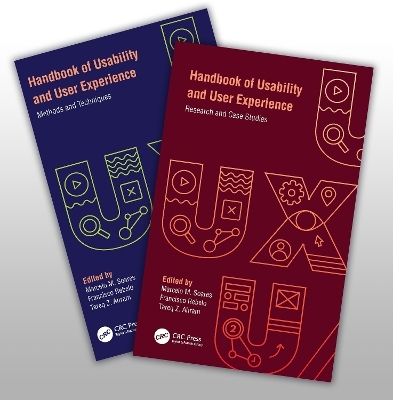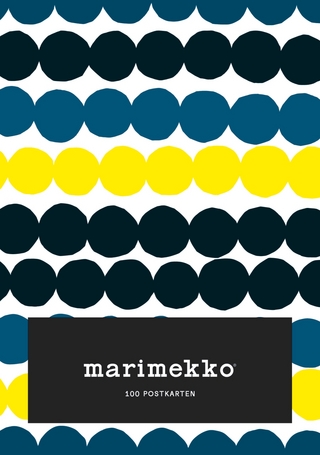
Handbook of Usability and User-Experience (UX), 2-Volume Set
CRC Press
978-0-367-35768-9 (ISBN)
- Titel z.Zt. nicht lieferbar
- Versandkostenfrei innerhalb Deutschlands
- Auch auf Rechnung
- Verfügbarkeit in der Filiale vor Ort prüfen
- Artikel merken
This two-volume handbook set introduces the state-of-the-art development in research and applications related to usability and user-experience. Volume one includes methods and techniques and volume two covers research and case
Studies.
This handbook set is essential for everyone that is interested in understanding how the principles of usability and user-experience can contribute to a design that ensures that the needs of the users have been properly met. The books will cover several areas, such as the conceptual aspects of usability and user-experience, the knowledge of human characteristics in design, the methodological aspects; the books will include intervention, examples of consumer products, digital systems, and augmented and virtual realities. This set will be of interest to those working in the fields of ergonomics, designers, engineers, as well as students and practitioners.
Dr. Marcelo Soares is currently a Professor in the School of Design at the Hunan University, China. He was recruited by the Chinese Government's 1,000 Talents program, which aims to invite international experts for the development of China. He is a licensed full professor of the Department of Design at the Federal University of Pernambuco, Brazil. He was an invited lecturer at the Technical University of Lisbon, Portugal, and the University of Guadalaraja, Mexico. He was a visiting scholar and lecturer at the University of Central Florida. He holds an M.S. in Production Engineering from the Federal University of Rio de Janeiro, Brazil. He was also awarded his Ph.D. at the Loughborough University in England. Dr. Soares is a Professional Certified Ergonomist from the Brazilian Ergonomics Association (ABRGO). He was president of this organization for seven years. He has also provided leadership in Human Factors and Ergonomics Latin America and internationally as a member of the Executive Committee of the International Ergonomics Association. He was appointed as the Chairman of IEA 2012 (the Triennial Congresses of the International Ergonomics Association) which was held in Brazil. His research, teaching, and consulting activities focus on manufacturing ergonomics, usability, product design, and information ergonomics. Dr. Soares has served on the editorial board of several journals including Theoretical Issues in Ergonomics Science (TIES), Human Factors and Ergonomics in Manufacturing, and many other publications in Brazil. Prof. Soares is co-editor of the Handbook of Human Factors and Ergonomics in Consumer Product Design and the Handbook of Ergonomics in Design: methods and techniques. He has also done significant research and consulting for several companies in Brazil. Francisco Rebelo, PhD, is Associate Professor at School of Architecture and lead of the Ergonomics Unity in CIAUD, Research Center in Architecture, Urban planning and Design. He holds a PhD (1986) in Ergonomics from University of Lisbon and the aggregation in Ergonomics Design (2002) at the same University. His activity of teacher and research is focused in User-Centered Design of Informational and Physical systems, usability, user experience and gamification. He published more than 200 articles, book chapters and is editor and co-editor of 8 books. Is external adviser of projects the Portuguese Foundation of Science and Technology and the Portuguese Innovation Agency. He is European Ergonomist and Portuguese representative in the Council of the Centre for Registration of European Ergonomists (CREE). Is Co-Chair of the Ergonomics in Design Conferences in Applied Human Factors and Ergonomics, since 2012. Has coordinated projects financed by the European Union, Portuguese Foundation of Science and Technology and companies (i.e. OGMA/Embraer, NOKIA, Siemens, VW, ACECIA, REFER, ADTRANZ, Nespresso). Tareq Ahram, PhD, is the Lead Scientist and Assistant Research Professor working at the Institute for Advanced Systems Engineering (IASE) at the University of Central Florida. He holds a Master of Science degree in Human Engineering from the University of Central Florida, Master of Science degree in Engineering Management (2004) and Ph.D. (2008) in Industrial Engineering from the University of Central Florida with specialization in Human Systems Integration and large-scale information retrieval systems optimization (search algorithms) and emotional deep learning analysis using text and sensory data feed. Dr. Ahram has served as an invited speaker at several Systems Engineering, design and human systems integration research meetings and workshops and served as program committee member and special speaker at the Department of Defense Human Systems Integration and Human Factors Engineering Technical Advisory Group- meeting 62, 63, and 64 held at NASA Ames - Human Systems Integration Division (DOD TAG). Dr. Ahram received the 2009 U.S. Exceptional Research Scientist Award and the 2013, 2014 IBM Research Faculty Award to support cutting-edge scientific research in data modeling and analytics. Dr. Ahram is currently the executive editor of the Springer Journal of intelligent Human System Integration and the series editor on Advances of Human Factors and Ergonomics AISC computing series
Vol 1
0
Chapter 1
Usability and User Experience: Methods and Models
Chapter 2
Implications and Methodological Guidance for the Study of Individual Differences in Usability and User Experience
Chapter 3
Three Methods of Usability-UX Task Analysis, REM, UX System Diagrams
Chapter 4.Remote Usability Testing
Chapter 5.Helping Them To See It – Using Full Size Mock-Ups to Achieve Usability
Chapter 6.Handbook of Usability and User-Experience
Chapter 7.User-Centred Change: New Perspectives on Technology Development and Implementation
Chapter 8.Using Usability to Improve Healthcare
Chapter 9.Usability and User-experience: Research and Case studies
Chapter 10.Getting the benefits from connecting digital health applications to complex healthcare systems
Chapter 11.Usability and User Experience of the Built Enviorment: Concepts Methods and Techniques
Chapter 12.A Human-Centered Architecture: Considering usability and user-experience in architectural design
Chapter 13.Digital Human Modelling in Usability
Chapter 14.User Experience and Information Architecture: Interaction with Recommendation System on a Music Streaming Platform
Chapter 15.Personified Virtual Assistants: evaluating users' perception of usability and UX
Chapter 16.User experience in remote context: emerging needs
Chapter 17.Applications of infrared thermography to evaluate the ergonomics and usability of products with a gestural interface
Chapter 18.Advanced User Experience Evaluations Using Biosensors in Virtual Environments
Vol 2
Chapter 1.UX Concepts and Perspectives – from Usability to User Experience Design
Chapter 2.Applying experience design methods to user requirements analysis
Chapter 3.Designing the Interactor – from User Experience to Interaction Experience.
Chapter 4.Encounters and Difficulties when Gathering User Experience Data
Chapter 5.Usability Evaluation for Exoskeleton Systems in Automotive Industry
Chapter 6.Proposals for the usability of automated vehicles' HMI
Chapter 7.Is the driver ready to receive just car information in the windshield during manual and autonomous driving?
Chapter 8.Interface design and usability evaluation of voice-based user interfaces
Chapter 9.Accessibility features in digital games that provides a better user experience for deaf players: a proposal of analysis methodology
Chapter 10.Game On: Using Virtual Reality to Explore the User Experience in Sports Media
Chapter 11.Expropriating bodies: immateriality and emotion in costume design
Chapter 12.UX, Design, Sustainable Development and Online Selling and Buying of Women’s Clothes
Chapter 13.User testing in an agile startup environment. A real-world case study.
Chapter 14.Dimensional aspects of usability of the beds
Chapter 15.Usability of the Back Seat of Wagon Cars - Recommendations for Design
Chapter 16.Parametric Design Method for Personalized Bras
Chapter 17.User Experience and Usability Review of a Smartphone Application: Case Study of an HSE Management Mobile Tool
Chapter 18.System perspective in Usability and UX design: a case study of an Indian cooking spatula
| Erscheint lt. Verlag | 31.5.2022 |
|---|---|
| Zusatzinfo | 69 Tables, black and white; 77 Line drawings, black and white; 103 Halftones, black and white; 180 Illustrations, black and white |
| Verlagsort | London |
| Sprache | englisch |
| Maße | 156 x 234 mm |
| Gewicht | 1620 g |
| Themenwelt | Kunst / Musik / Theater ► Design / Innenarchitektur / Mode |
| Mathematik / Informatik ► Informatik | |
| Technik | |
| ISBN-10 | 0-367-35768-2 / 0367357682 |
| ISBN-13 | 978-0-367-35768-9 / 9780367357689 |
| Zustand | Neuware |
| Informationen gemäß Produktsicherheitsverordnung (GPSR) | |
| Haben Sie eine Frage zum Produkt? |
aus dem Bereich


